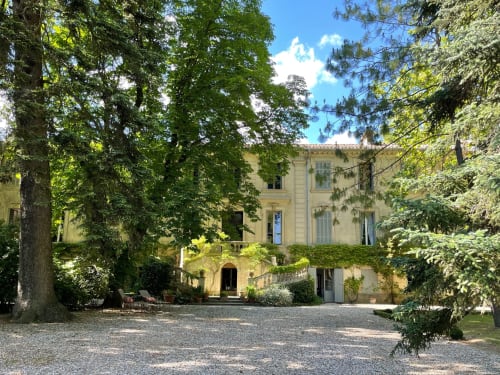"Do like Goethe: seek the Orient at your feet. The Orient of France is the South." Joseph Delteil
Exceptional guest houses with pools and gardens at the gates of Carcassonne
Let go, escape to the heart of Cathar Country!
In the heart of the Corbières, a few kilometers from City of Carcassonne and Lagrasse abbey, the Domaine de Montlaur offers three charming and prestigious guest house s with swimming pools. Refined linens, well-being treatments, beautifull private gardens, historical and gourmet discoveries, œnotourism, horseback riding ... the slow life as you ever dreamed.
An oasis of freshness
Treat yourself to a stay of total disconnection surrounded by nature. Let yourself dream in one of these houses with authentic character. Book now to experience precious, sweet and peaceful moments. Sheltered by high walls, the Domaine de Montlaur is a timeless parenthesis.
A shaded two-hectare park, a spectacular avenue of plane trees, sheltered by high walls, the Domaine de Montlaur seems to live out of time. Former property of
Edouard Niermans
, the famous architect of the Belle Epoque, this place of memory is an invitation to the sweetness of life in cathar country.

RENDEZ-VOUS AUX JARDINS 2024
The Domaine de Montlaur - first prize for the gardens of the Aude 2022 - opens its doors on June 3 and 4 for the national event of
"Rendez-vous aux Jardins"






Testimonials
A true paradise
Just exceptional.
The garden is a pure marvel. The house is a palace, tastefully decorated, with old-world charm and all modern comforts. The bedding is perfect, the swimming pool sublime. The host spoiled us with his welcome and his stories, particularly about the extraordinary history of the house and the estate.
Strong points: beautiful panorama Romantic · Quiet · Suitable for children. Visited in September 2023
MAGIC place
359 / 5 000
In a pretty little village in the heart of the beautiful Corbières valley. The house is superb, the park is magnificent, the swimming pool among the trees is splendid... Everything is refinement!
The chatelaine surrounded by her children and grandchildren will welcome you in the best way. We sometimes feel like we are part of this big family.
Wonderful family vacation spot
Rooms5/5. Service5/5; Location5/5
Highlights: · Beautiful panorama · Romantic · Quiet · Child-friendly · Good value for money.. Visited August 2023
Holidays as we like them
We will definitely come back with or without Covid!
a unique place.
ENJOY THE DOMAINE DE MONTLAUR

Fabulous gardens

A family affair
Nothing predestinate Edouard Niermans renowned architect of the Belle Epoque to acquire the Domaine de Montlaur by chance and to become a winemaker. An astonishing family story.

Horse rides in Corbières
DisEquestrian guide in Montlaur Val de Dagne, Alizée Niermans takes you to discover the Corbières along wild paths. Unforgettable horseback riding suitable for all levels.

œnotourism
Discover the Cathar Country
Vineyards, scrubland, rivers, ruins of Cathar fortress, endless beech, chestnut and pine forests, and further on the see, the salt marshes of Gruissan ... 27 kilometers from Carcassonne, the Domaine de Montlaur lives in a wild and preserved landscape of legends behind the mountain of Alaric where the Alaric II king is said to be buried with the famous Jérusalem treasure.
An extraordinary country to discover along the Cathar paths and the Roman roads.
















